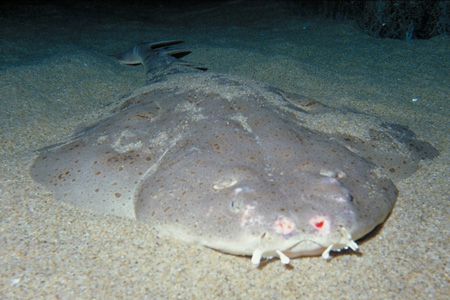Pacific angel sharks (Squatina californica) are named for their flattened bodies and large, wing-like pectoral fins. In appearance, angel sharks more closely resemble rays and skates, inspiring their heavenly name. Don’t let their divine title fool you, though—despite their angelic appearance, angel sharks contain some intimidating attributes.

By Mallory Johnson
Published: December, 2012
Pacific angel sharks (Squatina californica) are named for their flattened bodies and large, wing-like pectoral fins. In appearance, angel sharks more closely resemble rays and skates, inspiring their heavenly name. Don’t let their divine title fool you, though—despite their angelic appearance, angel sharks contain some intimidating attributes.
To their prey, these sharks are formidable predators. Angel sharks are ambush predators, also known as lie-and-wait predators, that catch their victims using stealth or deception. Angel sharks can lie still in the sand—effectively camouflaged for days without moving—while waiting for prey to swim by. Without warning, they will strike with vicious speed. It is this fearsome quality that has earned angel sharks the nickname "sand devils."
"They seem like relatively lazy animals that just sit there, but then they move with such amazing speed. Blink and you miss it," said Michael Grassmann, aquarist at Aquarium of the Bay. Angel sharks can strike within a tenth of a second.
Another advantage angel sharks use when hunting is their sight. With their eyes positioned on top of their heads, they are provided with a wide field of vision, giving them an ideal vantage point for detecting their prey while buried in the sand. When these sharks strike, they snap their heads up nearly 90 degrees to snatch their next meal.
Pacific angel sharks are commonly found off the California coast in fairly shallow waters, about 30-60 feet deep on average, spending their time on the sandy bottom of the ocean. They have greyish colored skin scattered with small black and white spots, ideal for staying camouflaged along the murky ocean floor. These nocturnal creatures typically grow to be about five feet long as adults.
Pacific angel sharks are categorized as "near threatened" by the International Union for Conservation of Nature, meaning that although they are not currently threatened with extinction, they could be in the near future if appropriate actions are not taken. Angel sharks were in huge demand for their meat in the 1980s, causing the overfishing of the species. The situation began to reverse in the early 1990s thanks to a voter-approved ban, allowing them to slowly repopulate. Today, the biggest remaining threat to these sharks is being caught as a result of bycatch.
While the number of Pacific angel sharks off the coast of California is gradually increasing, many sharks in the ocean are threatened due to overfishing and overconsumption. Sharks play a vital role in the ocean’s ecosystem, maintaining a balanced lifecycle within the underwater community. Aquarium of the Bay works to educate the public of the importance of sharks in the oceans ecosystem, debunking common myths about them, and inspiring their conservation.
In addition to educational programs, the Aquarium’s animal care team is conducting ongoing research on the subject to increase the body of knowledge of shark ecology and how to maintain them as a part of a healthy ecosystem. While the traits of angel sharks in their natural habitat have been well documented, there are still many unknowns about how they grow in different environments.
Biologists at Aquarium of the Bay got a unique opportunity when a litter of angel shark pups were born in the Aquarium’s main tunnel exhibit in 2009. Aquarium of the Bay is the first institution to report the birth of healthy angel shark pups while on exhibit. Though these pups are too small to remain in the tunnels with the Aquarium’s other 20,000 aquatic animals, the animal care staff keeps a close eye on them, documenting their growth, developmental behavior and successful animal care practices.
To learn more about Aquarium of the Bay’s shark conservation efforts and research, visit www.aquariumofthebay.org.
Mallory Johnson is the Public Relations Coordinator for Aquarium of the Bay, a nonprofit organization dedicated to protecting, restoring and inspiring the conservation of San Francisco Bay and its watershed.

